Andy's
Shot Glass Webstore - Astronomy Equipment
for Non-Gazillionaires
Telescopes
- Refractors
Orion
80mm ED Apochromatic Refractor
Salivate, my friends, for this is, in my opinion,
one of the best buys in the world of apochromatic
refractors! This is a fantastic buy! Apochromatic
lenses are simply a combination of lenses that focus
the colors to roughly the same spot, eliminating (or
nearly so, depending on the quality of the lenses)
the chromatic aberration common in achromats. I am
tempted to say it's not rocket science, but actually
it is. These scopes are not easy to make and usually
cost many thousands of dollars. Orion uses a special
ED (extra-dispersion) glass that accomplishes nearly
the same result for a fraction of the cost. It's a
great grab-n-go scope for quick setup and viewing,
but it really shines when you place a camera on the
back for those long exposures of night sky. One look
though this one and you'll be sold. |
|
100mm
ED Apochromatic Refractor
The 100ED is the 80mmED on steroids. The 4-inch aperture
pulls in 56% more light than the 80ED. It's 900mm
focal length is ideal for planetary and lunar viewing.
This telescope's focal ratio is f/9. This means that
you'll have to take longer exposures to get the same
effects, but you can add a focal reducer to it to
bring it within the realm of reasonable exposures.
Our side-by-side comparison with a scope that cost
over $2500 MORE than the 100ED revealed that the sharp,
crisp views of the 100ED were 90% of the more expensive
telescope. For less than $900, this one is a steal.
|
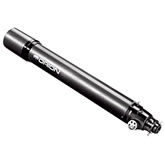
09975
|
Orion
120mm ED Apochromatic Refractor
The minute the 80mm ED Apochromatic Refractor hit
the market we were asking, "When will we see
the 100mm ED"? The second the 100mm ED hit the
market we were asking, "When will we see the
120mm ED"? Well, just as soon as I opened the
box that contained the 120mm ED I thought , "Refractors
don't get much bigger than this". This telescope
is everything we were hoping for. Just under 5"
of aperture with a 900mm focal length, this f/7.5
is indeed the rather large big brother to the 80mm
which is also an f7.5. I predict that within a short
time this will be one of the most used astrophotography
telescopes around. Even if you are not a photographer,
the views through this APO will knock your socks off.
It pulls in a whopping 43% more light than the 100mm
ED.
Read about our first night out with the 120ED here. |
|
Orion
Premium 102mm ED Apochromatic Refractor
This is not simply a 102mm copy of the popular 80ED
and 120ED refractors. Orion built this one new from
the ground up. New lenses, premium 2-speed focuser,
all alluminum construction, high-quality rings, and
features you find on the high-end telescopes, all
set this one apart from the rest. It has a focal length
of 714mm placing it's focal ratio at f/7. I was able
to get immediate results using a variety of cameras
on this scope. See
my article online.
This photo of the Flame Nebula (below) was taken
the first night I had it out.

|
|
SkyView
Pro 80ED EQ Apo Refractor With Upgrade Kit
If you've been through most of the articles on my
website you probably already know already how I feel
about the 80ED. Isn't it interesting that I use the
word "feel" rather than "think"?
When you see the views through the 80ED you'll understand
the difference. Orion now sells the SkyView Pro 80ED
WITH the upgrade kit! This is a great combination
for the beginning astrophotographer. The upgrade kit
allows you to find thousands of objects with the help
of its computerized object locator. Upgrade
Kit
|
|
SkyView
Pro 80mm ED EQ Apochromatic Refractor
If your budget won't allow you to spring for the
upgrade kit initially, you can always buy the SkyView
Pro 80ED without it, then, simply add it on at a later
date! It is still my contention that the SkyView Pro
equatorial mount is the best rig for the beginning
astronomer who is serious about growing in the hobby.
Combine it with the 80ED and you've got a winning
combination. |
|
Sirius
120ED EQ-G GoTo Refractor
The 120 ED refractor is another ground-breaking telescope
from Orion. Their perservering to give us the best
heavenly views possible without breaking the bank
has delivered to us yet another example of their success.
The Sirius EQ-G equatorial mount is a superb match
to the 120ED. Whether you're in it for the views or
for astrophotography or BOTH, this could be the combination
for you.
Top |
|
Telescopes - Reflectors
SkyView
Pro 8 EQ Reflector With Upgrade Kit
If you've gone through my website even casually,
you'll know that my first guideline for purchasing
a scope for deep-space viewing is: "Aperture
is everything". The 8" aperture of the SVP
8EQ will allow you much better views of those dim
galaxies. While it has been my contention for some
time that the SkyView Pro mount is the best place
for a beginning astronomer to start, I am even more
adamant about the SVP 8EQ as a total package. This
is the place the beginner should start. It is a great
rig for viewing and astrophotography as well!! Upgrade
Kit |
|
| Orion
Atlas 8 EQ-G GoTo Reflector
The Atlas is the flagship of the Orion mounts. It
is a GOTO mount with autoguiding capabilities! Add
to it the formidable 8" Newtonian reflector and
you have a comination that is tough to beat. The Atlas
equatorial mount will pack 40 lbs. of scope and accessories
and the 8" optical tube assembly only weighs
16 lbs! That leave you lots of room for guidescope
and cameras! For the beginning serious astrophotographer
whose budget allows, this could be the scope for you. |
|
Orion
Atlas 10 EQ-G GoTo Reflector
Warning: This Scope/mount combination
is NOT for the faint-hearted. This is freakin' Hubble-in-the-backyard.
Ok, maybe that's a bit of an exageration, but my point
is: Don't buy this scope on a whim. If you're into
whimming, go whim on one of the smaller rigs. But
if you do whim on this one, be prepared for a trip
through the heavens that few people experience. The
10" aperture gathers 53% more light than an 8"
aperture. Take this scope out to a dark site and you'll
declare "life is good". |
|
StarBlast
Astro Telescope
This scope cracks me up. Why? Because it's WAY more
scope than I had as a kid and twice as cute. The 60mm
telescope that my mom and dad gave me for my 12th
birthday was junk compare to this. I have a friend
who owns a 15" truss dob and a collection of
expensive eyepieces and what did he show up to our
usual Friday night gathering with? THIS!!!! This is
meant to be a scope for kids, but apparently others
get a blast out of them. No pun intended. The StarBlast
is a 4" aperture reflector that kids will love
and use for many years. For less than $200 you may
be instilling in your child a foundational love for
science that could carry into their adult years. I'll
bet anything that you'll love it as much as they do. |
|
StarBlast
4.5 Imaging Reflector OTA
Many newbie amateur astronomers ask me which affordable
scope they should buy that will give them the best
compromise between visual astronomy and astrophotography.
My answer used to be one particular scope (namely
Orion's 8" OTA). Even though I am still convinced
of that choice, I now have an answer that is much
better:
Buy two! Buy the scope that will
give you the best visual astronomy, no matter the
size or focal ratio. THEN, also buy the StarBlast
4.5 Imaging Reflector as a second OTA that is made
precisely for astrophotography and is incredibly affordable!
For about the cost of a good eyepiece, you can have
a 4.5-inch, f/4 telescope that is free of chromatic
aberration and very little coma! It only wieghs a
few pounds so you can mount it on your existing equatorial
mount and start taking photos! I'm seated at my desk
looking over my computer screen at my StarBlast on
my wall rack which arrived a week ago and has YET
to be used. I'm waiting on the sky to clear.
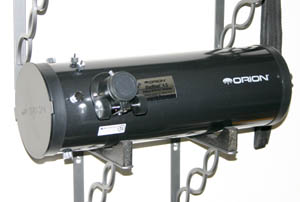
|
|
SkyQuest
XT4.5 Dobsonian Reflector
This another great scope for starting children in
a life-long love of the sky. It's larger than the
StarBlast, but still easily handled by wee people.
I saw one of these at our viewing site being used
by the most excited 11-year-old on earth. He beamed
like the sun whenever grownups would ask if they could
take a look through his telescope. He beamed even
more when the adults muttered the same "WOW"s
and "OHMIGOD"s that they did after viewing
through the "adult" scopes. This is not
a toy. |
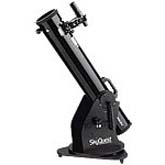
09804
|
SkyQuest
XT6 Classic
Classic entry-level Dobsonian telescope combines
quality optics with a stable mount. See crisp images
from the craters of the moon to the edge of the galaxy;
point-and-view ease of use.
- Ample light grasp
- Portable
- Stable mount
- Quick setup and take-down
- Easy to operate
- Affordable
|

09185 |
IntelliScope
Computerized Object Locator
Computerized Pointing Access to 14,000+ Objects!
- Plug in to any SkyQuest XT IntelliScope for computerized
pointing access to celestial objects
- Locates over 14,000 galaxies, nebulas, star clusters,
and more with pushbutton ease
- Two-line, backlit LCD screen
- Illuminated keypad; illumination is adjustable
- User-friendly menu buttons
The IntelliScope Computerized Object Locator requires
one 9-volt battery, which is included. Comes with
coil cord, altitude encoder, adhesive-backed hook-and-loop
fastener for mounting Object Locator on telescope,
and illustrated instructions for use.
|
|
SkyQuest
XT6 IntelliScope with Object Locator
Affordable beginner's Dobsonian telescope!
- Locate more than 14,000 fascinating celestial
objects with pushbutton ease with included controller
- 150mm aperture and 1200mm focal length (f/8.0)
for brighter, more detailed images
- Features a streamlined Dobsonian base for unflinching
stability and superior balance
- Includes 2 eyepieces, finder scope, focuser, and
FREE Starry Night astro software
|
|
SkyQuest
XT6 IntelliScope without Object Locator
This affordable beginner's Dobsonian telescope contains
the electronics which will allow you to upgrade later
with the addition of an Object Locator. This is a
great place to start for the beginner with a minimal
budget, but you want something that will give you
the tour of the heavens you hoped for.
|
|
SkyQuest
XT8 IntelliScope With Object Locator
One evening at the dam I was in the process setting
up my equatorial mount when a white van
pulled up. The owner got out and waved. I waved back
and greeted him. I turned to retrieve my scope mount
from the back of my truck, then walked back to set
it on the tripod. Before I was done tightening the
knob that holds it in place, the white van guy had
already set up his 8" IntelliScope, and was seated
and viewing. I had to get one. Now THAT is what I
call "grab-n-go" technology. The object
locator allows you to locate over 14,000 objects.
Far-away galaxies are just a button push away! The
story is not over. Read on to the XT10. |
|
SkyQuest
XT8 IntelliScope Without Object Locator
If this Dobsonian falls within your budget then you
should seriously consider it. Eight inches of aperture
is a whole lot of mirror for a beginner. You'll see
detail in such objects like Orion's Nebula that will
keep you in awe for hours. Saturns rings will leap
out at you on a clear night! You'll see the divisions
in the rings themselves! The 8" mirror is Orion's
techonological sweet-spot. They make these mirrors
VERY well. Later, when you can afford the Object Locator,
it's no big deal to upgrade.
|
09183
|
SkyQuest
XT10 IntelliScope With Object Locator
When I told you the story about the white
van guy, (see SkyQuest
XT8 IntelliScope With Object Locator above)
I didn't tell you that when I went to purchase my
own IntelliScope that I decided to upgrade to the
XT10. Why? Well, I already owned an 8" reflector
and didnt need two. Besides, the XT10 isn't THAT much
bigger than the 8, is it? Well...yes and no. 'Yes'
because the 10 is a light-bucket! It gathers 53% more
light than the 8" aperture. But, 'no' because
it still fits across the back seat of my vehicle.
So it's almost as portable as the XT8, albeit a tad
heavier. But the views are worth it. If you can afford
the 10", by all means, go for it. You won't regret
it. |
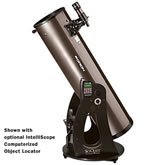
27184
|
SkyQuest
XT10 IntelliScope Without Object Locator
You have all the aperture you need to keep you searching
the skies for years and years, but at a reduced priced
becauase you're not getting the Object Locator. When
you ARE able to save those bucks then you can always
order later. I still have my XT10 for those nights
when all I want to do is sit for hours studying deep
space objects, wishing I could go there. This scope
is a trip into space.
|
09184
|
SkyQuest
XT12 IntelliScope With Object Locator
Let's all say it together: M O N S T E R S C O P
E . This is a behemoth. It will not fit across the
back seat of a small or mid-sized vehicle. I doubt
that it will fit across the back seat of a HumVee
(though I've not tested that theory). This one's got
to ride in the back of the truck. If you have a bad
back, get a smaller scope. If you're a beginner or
just curious about astronomy, get a smaller scope.
But if you have a serious dose of aperture fever and
have a burning desire to move up to the big league,
this is definitely the one to buy. The XT12 is a serious
scope for serious observers. Using this scope is quite
a trip through the cosmos. It'll blow you out of your
socks. |
|
SkyQuest
XT12 IntelliScope Without Object Locator
Let's say it together: MONSTERSCOPE WITHOUT THE OBJECT
LOCATOR. Almost repititious isn't it? But if you know
your way around the heavens already or just enjoy
the hunt then this is the light bucket for you. My
cousin bought one of these and every time I gaze into
the eyepiece I am overwhelmed with the light-gathering
capabilities. You'll see the dust lanes in galaxies
that are just a blurring mass in an 8-inch scope.
Star Clusters will keep you enthralled all night on
one of these. It is one amazing telescope.
Top |
09189
|
Cassegrains
Mounts
|
Atlas
EQ-G GoTo Mount
Boy do I love this!
- 10 slewing speeds
- 3 tracking speeds
- backlash compensation
- smooth motion
- 44 lb. load capacity
|
- programable periodic error correction
- auto-guiding capability
- 13,436 object database
- threaded protective polar alignment scope
cover
|
Check out my review!
It includes:
- slewing demo
- polar alignment demo
- two star alignment demo
- finding objects demo
|
|
|
Orion
SkyView Pro Mount
I'll repeat myself here since it's important for
new amateur astronomers to know: The SkyView Pro equatorial
mount is the perfect mount for beginners who feel
reluctant to drop a load of money coming out of the
gates. This mount is sturdy and perfect for small
to medium sized telscopes. The German equatorial mount
was designed to compensate for the rotation of the
earth. You might say it tracks the celestial objects
in space. Once you learn how to set it up you'll appreciate
it's ability to keep whatever object you line up in
the eyepiece there for a long time.
If you would like to get your feet wet in astrophotography,
this mount is capable of giving you the satisfaction
you seek IF you stick to very fast scopes. Fast is
a term used to describe certain scopes with a low
focal ratio. The focal ratio of a scope is the focal
length divided by the aperture. So, a scope that is
1000mm in focal length and has a 200mm aperture would
be an f/5. Anything approaching an f/5 would be fast,
and anything around f/10 and higher would be slow.
This mount is great for those fast scopes.
If you are just beginning, on a budget and want to
go equatorial, this is the mount for you.
Top |
|
Misc Products
Polar
Alignment Scope for the SkyView Pro Mount
I only have one thing to say about the Orion Polar
Alignment scope: Why don't you already own one?? It's
fast, easy and a "must-have". This is the
quickest method of insuring that your equatorial mount
is polar aligned for visual observation.
Top |
|
Dovetail
Mounting Plate, 13"
It's important, when you're mounting a longer telescope
that you get your rings as far apart as you can. This
is where owning extra dovetail mounting plates comes
in handy. Notice in the photo on the right I mounted
a 13" plate for the large refractor on the bottom
as well as the smaller refractor on top. Having the
two mounting plates reduces the "flexture"
(or "give") in your mount, thereby making
it much more stable for astrophotography.
|
|
Upgrade Kits
Focusing
2"
Crayford-Style Focuser
If you have the old-style rack and pinion focuser,
you should replace it with one of these. Watch my
video about the Crayford-Style
Focuser.
|
|
Helical
Fine-Focusing Adapter
If you don't have one of these already, please do
yourself a favor and click the link above and buy
one. I own two of them. I keep one for my accessory
box and one for my XT10. This goes into the 2"Crayford
focuser that comes with your telescope. Then, you
put your eyepiece into this. Turn the big knobs on
the focuser to get a rough focus, then turn this helical
focuser left or right to achieve a very fine focus.
The only thing that could possibly be better for achieving
a smooth, fine focus is to spend hundreds of dollars
for a dual-speed focuser. This is worth every penny
you pay for it. Once you use one, you'll wonder why
you didn't buy one a long time ago.
Top |
|
Cameras
StarShoot
II Deep-Space CCD Color Imaging Camera
Holy Guacamolies....and to think I almost passed
up buying one of these! I'd been playing with an expensive
CCD camera and really questioned whether I even had
a place for the StarShoot II in my camera box. The
very first time I used it, it absolutely blew me away.
This camera could go head to head with ANY camera
in its price range, but as you can see, it holds its
own against cameras costing 5 times as much! The photos
below were taken with the same telescope (Orion 120mm
ED) under the same conditions. The StarShoot is a
one-shot color while the other camera is monochrome
and I had to shoot LRGB. I'm sure one day I'll get
much better at LRGB photography, but with the StarShoot,
I got immediate results! If you're a beginner who
can afford the $699 price tag, this is THE place to
start.

Top |
|
Eyepieces
Set
of three Q70 widefield eyepieces
|

24708 |
- 17mm
Stratus Wide-Field Eyepiece 08245
- 8.0mm
Stratus Wide-Field Eyepiece 08243
- 21mm
Stratus Wide-Field Eyepiece 08246
- 13mm
Stratus Wide-Field Eyepiece 08244
- 5.0mm
Stratus Wide-Field Eyepiece 08242
- 3.5mm
Stratus Wide-Field Eyepiece 08241
For those who cannot afford to spend $300 apiece
on TeleVue Naglers and Panoptic eyepieces, the Stratus
Wide-Field Eyepieces are for you. Are they as good
as TeleVue Naglers and Panoptics? No. But, we have
compared the Stratus wide-fields to eyepieces costing
twice as much and have found none that could beat
it. These are the best buy for the money.
Did you notice that I put the 17mm on the top of
the list? That was no accident. I think it's the best
one of the bunch AND the best place to begin if you've
decided to build a collection of eyepieces. I've listed
them in the order that I would buy them. |
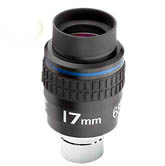 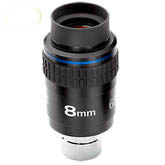
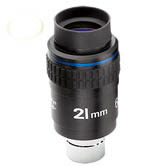 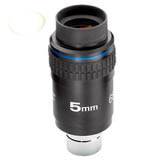
|
Ultrascopic
5mm Illuminated Reticle Eyepiece
If you are interested in accurate polar alignment,
this eyepiece is for you. This Ultrascopic eyepiece
has double-crosshair illuminated reticles which allow
you to perform drift-alignments in your Newtonian
or short focal length scope (1200mm focal length or
shorter). For those of you with a Schmidt-Cassagrain
with long focal lengths (2000mm +), you might consider
the 12mm Ultrascopic Illuminated Reticle Eyepiece. |
|
Tele
Vue 24.0mm Panoptic Eyepiece
Here is where I depart from my "astronomers-on-a-budget"
philosophy. The TeleVue 24mm Panoptic eyepiece is
expensive, but let me say unequivocally, that if you
can afford this one, buy it. Scrimp, save, sell unused
equipment, sell lemonade on the street, breed kittens
for sale, juggle on the streetcorner singing Stairway
to Heaven for money, do whatever you can (within the
limits of the law) to buy one of these. The quality
is THAT good. Uncle Al should be up for the Nobel
Peace Prize for this one.
I apologize if I made my budget-minded fans cry here,
but a man's gotta do what a man's gotta do. There
are times in a person's life when they must depart
from their usual path for the good of mankind. This
is one of those times. For those of you whose spouse
would divorce you if you came home with a $300 eyepiece,
then take my advice and buy an Orion Widefield Stratus.

Top |
|
Filters
Orion
Oxygen-III Nebula Filter, 1.25"
I have a movie in my articles section that covers
most of the filters listed below. Check
it out. |
|
| Orion
Oxygen-III Nebula Filter, 2" |
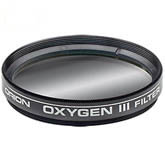
05582
|
| Variable
Polarizing Filter, 1.25" |
|
| Variable
Polarizing Filter, 2" |

05562
|
| Stargazer's
Filter Set, 1.25" |
|
| Stargazer's
Filter Set, 2" |
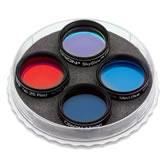
05592
|
| SkyGlow
Broadband Filter, 1.25" |
|
| SkyGlow
Broadband Filter, Schmidt-Cass |
05658
|
| SkyGlow
Broadband Filter, 2" |
05659
|
| UltraBlock
Narrowband Filter, 1.25" |
|
| UltraBlock
Narrowband Filter, 2" |
05657
|
| UltraBlock
Narrowband Filter, Schmidt-Cass |
05656
|
Solar
Filter – StarMax & Apex 102, SVP 100, ED80
Top |
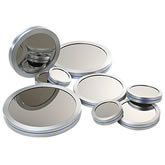
07798
|
DVDs
- Comet
Hunters / Asteroid SeekersDVD 17168
Comet Hunters/Asteroid Seekers is great information
about a few dedicated astronomers who search the
heavens for things that could bump into the earth.
There are a few ideas that anyone who would like
to join the search can borrow .
- Wheels
on Mars DVD 17169
The best documentary I've seen about the Mars
mission to-date!
- Searching
for Superstars DVD 17165
I watched this DVD just about the time there
was a supernova in M51. It was quite an education
to see what forces are involved when a star goes
supernova.
- Danger!
Solar Storm DVD 17167
I have to tell you, this DVD is an eye opener.
Want to see what in FACT is the
major contributor to global warming? This is IT.
Our sun.
- Starry
Night DVD Gift Set 17177
These DVDs are VERY cool. I make them available
to friends for viewing. You never know when you'll
create another astronomy enthusiast.
|
|
Astronomy Software
Starry
Night Astrophoto Suite
I'm sure that many of you are familiar with the Starry
Night software that comes free with many Orion Products.
It's a great way to keep abreast of what celestial
objects are over your head and helps you locate them.
Well, Starry Night Astrophoto Suite is your quantum
leap into techno-coolness. It has all the features
of the demo software plus a ton more. Using the Astrophoto
Suite, you can control an Atlas EQ-G
GoTo mount! When someone comes up behind you and
asks what you're doing you can point out a celestial
object on your computer screen, right-click on it
and the telescope begins moving (we call it "slewing")
to that object.
If you don't have the Atlas EQ-G mount, you can use
this software in combination with the Orion Intelliscope.
That's right, the Intelliscope hand controller has
an RS-232 jack that allows you to use your laptop
to control it!
That's not HALF of it! You can also control your
CCD camera to take astrophotos, then digitally process
those photos using the MaximDL digital imaging software
that is included in the package. It does it all! Click
a button to take dark frames and the software automatically
subtracts them from your subsequent shots! This is
worth EVERY penny! Check it out.
Life is good when astronomy is easy.
|
|
Assorted Products
StarTarg
Draggable, rotatable
crosshairs that will pop up on top of everything on
your desktop. Excellent aid for performing a drift
alignment if you have a CCD camera capable of placing
a live image on your computer desktop. (Detailed
information here)
StarTarg
now works with the Windows Vista OS! Doug Braidwood
on the down under side of the planet figured it out.
Here's how to get it to work on Vista:
1. Right click on startarg.exe and go to properties.
2. Click on the compatability tab.
3. Check the Windows XP compatability checkbox and
select the Run as Administrator checkbox and it works
fine. |
|
Browse
for other astronomy equipment
|

